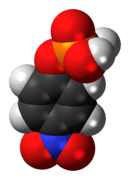para-Nitrophenylphosphate
para-Nitrophenylphosphate (pNPP) is a non-proteinaceous chromogenic substrate for alkaline and acid phosphatases used in ELISA and conventional spectrophotometric assays.[1] Phosphatases catalyze the hydrolysis of pNPP liberating inorganic phosphate and the conjugate base of para-nitrophenol (pNP). The resulting phenolate is yellow, with a maximal absorption at 405 nm.[2] This property can be used to determine the activity of various phosphatases including alkaline phosphatase (AP) and protein tyrosine phosphatase (PTP). The substance is sensitive to light, and thus should be stored protected from light. This is also important after adding the substrate to the mixture and before reading. −20°C is the optimal storage temperature.[3]
| |||
| Names | |||
|---|---|---|---|
| IUPAC name
(4-nitrophenyl) dihydrogen phosphate | |||
| Other names
pNPP | |||
| Identifiers | |||
3D model (JSmol) |
|||
| ChEBI | |||
| ChEMBL | |||
| ChemSpider | |||
| ECHA InfoCard | 100.005.777 | ||
PubChem CID |
|||
CompTox Dashboard (EPA) |
|||
| |||
| |||
| Properties | |||
| C6H6NO6P | |||
| Molar mass | 219.09 | ||
| Related compounds | |||
Related compounds |
Paraoxon | ||
Except where otherwise noted, data are given for materials in their standard state (at 25 °C [77 °F], 100 kPa). | |||
| Infobox references | |||
References
- Lorenz, Ulrike (2017-05-07). "Protein Tyrosine Phosphatase Assays". Current Protocols in Immunology. 91 (1): 11.7.1-12. doi:10.1002/0471142735.im1107s93. ISBN 978-0471142737. PMC 3097125. PMID 21462163.
- MacKintosh, C. (1993). In D.G. Hardie (Ed.). Protein Phosphorylation: A Practical Approach. 221. New York: IRL Press.
- Biolabs, New England. "p-Nitrophenyl Phosphate (PNPP) - NEB". www.NEB.com. Retrieved 29 October 2017.
This article is issued from Wikipedia. The text is licensed under Creative Commons - Attribution - Sharealike. Additional terms may apply for the media files.

